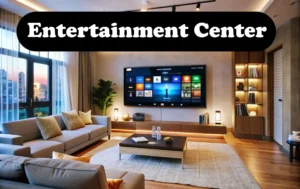Your cart is currently empty!

Every Thing You Need to Know About Selecting Entertainment Centers!
I
Introduction
An entertainment center is more than just a piece of furniture; it is the focal point of a living room, bettering practical functions while also looking great. Whether you are a movie buff, a gamer, or just someone who thinks a neat space augments enjoyment of life, having the right entertainment center can really open up your home into a stylish yet practical relaxation and entertainment area. This guide will lead you all the way from types and materials to design considerations and organizational tips for entertainment centers.
Types of Entertainment Centers
Entertainment centers find their expression through different genres and their sizes on this earth; hence the different choices are available to cater to different needs and tastes.
Here are a few common varieties:
Wall Units
These massive, multifunctional entities extend for the length of the wall. They are capable of housing entertainment systems and storing books and decorative articles. Best suited for bigger living rooms, they artificially create a built-in look that would enhance the room’s appeal.
TV Stands-
A very simplistic form of a stand is compact and made to carry the television with basic storage for cables and different accessories. Suitable for small spots or apartments.
Corner Units
These entertainment units are such that they precisely fit into the corner and maximize the area whilst providing storage for media essentials.
Hutch and Cabinet Style
These types of units consist of enclosed cabinets and shelving, hence it is an ideal style for hiding clutter and giving it a tidy and well-organized appearance.
Floating Entertainment Centers
Wall-mounted designs lend themselves to a sleek modern aesthetic, as well as elevating the out-of-the-wall area. They are perfect for modern interiors.
Materials and Durability
While choosing your entertainment center, focus on the material, as that will define its durability and aesthetics.
Some common options include:
Wood – The most commonly used are solid wood types such as oak, walnut, and maple that will stand the test of time and look warm and classic. Engineered woods, for example, MDF, tend to be cheaper but less sturdy.
Glass – Typically incorporates shelves or doors into an entertainment center, glass gives a modern flair but requires frequent cleaning.
Metal – Sleek and industrial-looking, relatively easy to maintain and generally durable.
Mixed Materials – Many entertainment centers use a combination of wood, glass, and metal for a distinctive, fashionable touch.
Choosing the Right Size
Size is one of the most important factors when selecting an entertainment unit.
Consider the following:
TV Size Compatibility – Ensure the unit can accommodate the space and weight of your television.
Room Proportion – A large unit in a small space can prove to be overbearing, while a tiny stand in a large room may appear misplaced.
Storage Needs – Choose a unit that offers more than enough shelves, cabinets, and compartments to house any media device, game console, and decor item.
Style and Aesthetic
Decorators make sure their entertainment centers fit in with their existing decor-like an extension of it. Modern, rustic, traditional, industrial, and mid-century modern have become favorites.
Modern – clean lines, minimal designs, and neutral color.
Rustic – with a wooden finish, distressed appearance, and earthy tones.
Traditional – elegant detailing, with rich woody tones, classical designs.
Industrial – the combination of metal and wood, sharp and raw looking.
Mid-century modern – retro style and tapered legs, warm wood tones.
Organization and Cable Management
To keep your entertainment center neat and functioning:
Cable management systems prevent tangling of wires.
Small accessories should be placed in baskets or storage bins.
Decorative items include books, vases, and picture frames, and these give forms to the entertainment center-beauty and utility.
Select a unit with adjustable shelves in order to be flexible with storage.
Smart Features and Customization
Featuring modern entertainment centers, it ranges from:
LED lights set for ambient light.
Built-in charging stations for devices.
Smart storage solutions, sliding panel, or hidden compartments.
Configurable to adapt to your changing needs.
Conclusion:
An entertainment Centre, either in the form of a wall unit or a floating shelf, combines elegance with functionality for the main room of your house. The correct design, material and size enhances the aesthetics and functionality of your place. When one keeps in mind shelving, organization and smart features, the result is a well-balanced entertainment hub specially built for him/her. Take time to check out the various options available so that you can find an entertainment centre that complements your decor and fits in with your lifestyle.

Leave a Reply